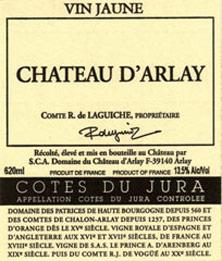Information
Regarded as the oldest winemaking château in France, Château d’Arlay has, in the past, been home to Minim friars and the Countess of Lauragais to name just a couple. In 1960, the Count of Laguiche decided that the château should make wine once again like it used to in the Middle-Ages. Today, his son Alain is in charge of the venture. Alain has a very modern approach to vinifications but chooses a more traditional style when it comes to the ageing of the wines. The wines are matured in the magnificent cellars of the Château that date back to the 17th century. There are around 25 hectares of vines that are planted to Pinot Noir, Trousseau, Poulsard, Chardonnay and Savignin. The vines are situated on slopes at an altitude of 200 to 240 metres. Some of the vines are relatively old, planted in 1953. This domain has an organic approach but does not possess certification. One of the icons of the Jura, the wines of Château d’Arlay are a must try!
Created by decree on 31 July 1937, the Côtes de Jura appellation is the Jura's most extensive appellation. It extends from the north to the south of the wine-producing area, and includes a wide range of contrasting terroirs. For this reason it offers a excellent opportunity to explore the various expressions of the Jura's grape varieties. The Côtes de Jura appellation consisted of 60 communes in 1937. Today it numbers 105, with a total area of 640 hectares of vines. While all of Jura's various wines are produced in the Côtes de Jura AOC, production mainly consists of white wines and Crémant de Jura, with a rounded, fruity, generous character. In terms of production, it is the second largest AOC in the Jura. Château d'Arlay produces two dry white wines: a 100% Chardonnay cuvée spéciale, made from old vines in a locality known as "à la Reine" and vinified and aged exclusively in vats. It is a dry yet very smooth wine, that is somewhat reminiscent of Saint Véran and some Alsace wines, with aromas of raisins, honey, flowers, nuts, figs and a hint of minerality. The other wine is a traditional white wine, consisting of a blend of one third Savagnin and two thirds Chardonnay matured for three years in casks that are kept topped up. The Château also makes a vin jaune and a vin de paille. A listed historic monument, Château d'Arlay was once a monastery for the Order of Minims. It became the residence of the Comtesse de Lauraguais in the 18th century. In 1960, the Comte de Laguiche undertook to re-establish the property that had been created in the early Middle Ages by the Comtes de Chalon-Arlay, the Princes of Orange. His son Alain, who currently manages the winery, places an emphasis on using modern vinification methods, followed by traditional ageing in casks in the château's magnificent 17th century cellars.
Consult price estimate for Château d'ArlayPrice estimate for wine from the same producer
Region: Jura
Producers and wineries: Château d'Arlay
Colour: white
Appellation: Côtes du Jura
Owner: Château d'Arlay
Service temperature: 12°
to statistics for over 126,000 price estimates

